-
Countries
-
Data and Analysis
-
Special Focus
-
Crisis Responses
Assessment Report

Contact
DTM Europe, DTMMediterranean@iom.int
Language
English
Location
Bosnia & Herzegovina
Period Covered
Jan 01 2024
Jan 31 2024
Activity
- Survey
- Flow Monitoring
This report provides insights into the profiles, experiences, needs, routes travelled and intentions of migrants transiting through Bosnia and Herzegovina (BiH).1 Data was collected from 3 January to 31 January 2024. IOM carried out a route observation exercise in the Republika Srpska, Sarajevo Canton, Posavina Canton, Tuzla Canton, Bosnian-Podrinje Canton and Una Sana Canton to monitor trends in entries and exits as well as transit modalities within BiH. IOM also surveyed 872 migrants in active transit locations such as bus stops or at key entry and exit locations throughout the country as well as in four transit reception centres (TRCs) in BiH (Lipa, Ušivak, Borići and Blažuj).
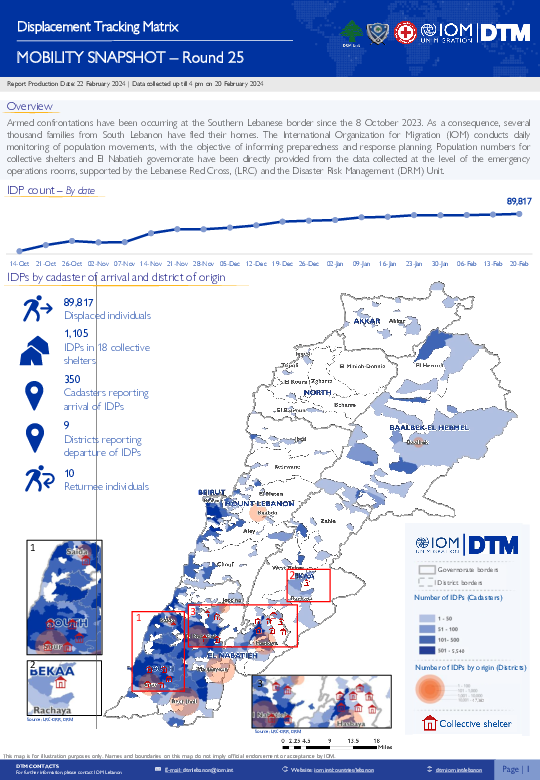
Contact
dtmlebanon@iom.int
Language
English
Location
Lebanon
Period Covered
Oct 10 2023
Feb 20 2024
Activity
- Mobility Tracking
- Baseline Assessment
Since October 8 there has been an increase in cross-border incidents between Israel and Lebanon, resulting in the displacement of people both within the South and elsewhere within the country. Since October 10, the Displacement Tracking Matrix (DTM) has been conducting the daily monitoring of population movements. The objective of the exercise is to inform preparedness and response planning.

Contact
DTM South Sudan, SouthSudanDTM@iom.int
Language
English
Location
South Sudan
Period Covered
Jun 19 2023
Jul 19 2023
Activity
- Survey
- Return Intention
This study provides a comprehensive assessment of the multiple dimensions of fragility in South Sudan at the subnational level: political and legal, social, economic, security, and environmental. By providing evidence-based contextualized insights, the study seeks to guide the development of programming and policies to support peacebuilding efforts in South Sudan, in in alignment with the Humanitarian Development Peace Nexus (HDPN) approach. South Sudan is an important case for the study of fragility because the country is in the process of transitioning from a humanitarian-only response plan to a more recovery-focused approach in which fragility, rather than armed conflict, is the primary barrier to sustainable peace and development.
The study deepens the understanding of how fragility varies across these dimensions within four distinct South Sudanese counties (Yei, Kajo-Keji, Bor, and Wau). It explores the impact of this variation on the local contexts where peacebuilding interventions are carried out by IOM and partners. To address these objectives, the research was conducted through a face-to-face household survey involving 1,595 adult respondents (51 per cent female, 49 per cent male), with approximately 400 participants in each of the four selected counties.
The findings reveal a complex landscape across multiple fragility dimensions. On the political dimension, there is a notable lack of confidence in government authorities at local, state, and national levels, and concerns persist about expressing political opinions in the context of national elections. However, there is a positive trend towards greater acceptance of women in politics. In the security dimension, perceptions vary across counties, with overall low trust in security actors and a reliance on informal mechanisms for dispute resolution. Informal armed groups continue to be seen as a source of insecurity, and concerns about renewed conflict linger. Opinions on transitional justice, accountability, and reconciliation are divided. In the social dimension, feelings of community acceptance are generally high, regardless of displacement status, although these results should be interpreted cautiously in light of potential social desirability bias on sensitive questions. Gender-based violence (GBV) including child marriage remains a challenging issue. Around 23 per cent of respondents had experienced Housing, Land, and Property (HLP) disputes, which are typically resolved by village chiefs, and acceptance of women’s land ownership was mixed. Lack of documentation of legal ownership and conflicts over natural resources including cattle and water are significant risk factors for HLP disputes. The majority of respondents rely on subsistence farming for their livelihood, and have limited purchasing power. Many also report an increase in the number and frequency of natural hazards contributing to environmental fragility.
The analysis shows important differences between the four counties across different dimensions of fragility. Bor stands out as the county with the highest levels of security, environmental, and economic fragility. Kajo-Keji, on the other hand, exhibits the highest level of political fragility, alongside high scores in economic and environmental fragility. Yei County records the highest level of social fragility and moderate levels of political and security fragility. In contrast, Wau County displays moderate overall fragility levels, with the lowest political fragility scores, along with low levels of social, economic and environmental fragility. Although the baseline pilot study does not enable precise identification of the drivers of subnational variation in fragility, we suggest potential explanations based on local context that could be more rigorously tested with follow-on studies.
OBJECTIVES
This study aims to assess multiple dimensions of fragility in South Sudan at the subnational level in order to inform evidence-based and locally contextualized peacebuilding programmatic interventions in line with the HDPN approach.
Specifically, the study is designed to advance the following objectives:
- Improved understanding of how variation in fragility across five dimensions (political and legal, social, economic, security, and environmental) in four different counties affects the local contexts where IOM and partners implement peacebuilding interventions;
- Inform evidence-based and context-specific programming and policies within the HDPN approach;
- Identify remaining knowledge gaps and open questions in need of further research including the effects of different types of fragility on efforts to promote sustainable development and peace.
Understanding variation in fragility across different regions within the country is crucial for developing context-specific interventions in line with the HDPN approach. This pilot study is the first empirical analysis of subnational variation in fragility in South Sudan across five different dimensions: political and legal, economic, social, security, and environmental. The results provide detailed insights into the needs of the four counties studied, which have broader implications for IOM programming in South Sudan.

Contact
DTM South Sudan, SouthSudanDTM@iom.int
Language
English
Location
South Sudan
Period Covered
Aug 31 2021
Oct 14 2021
Activity
- Survey
- Return Intention
1. This report provides field-level data to complement and validate findings from the 2020 Flood Damage and Needs Assessment (FDNA) on the 2020 seasonal floods (June-December) in South Sudan which largely relied on the analysis of remote sensing and geodata. The World Bank tasked IOM to conduct field assessments in three payams (administrative level 3) to collect empirical data from flood-affected areas to verify and substantiate findings from the FDNA.
2. The FDNA Field Validation combines four sources of primary data: two quantitative tools mapping the flood impact and exploring community responses of which one was conducted at the boma level (administrative level 4) and one at a more granular level (facility, livelihood area and settlement level), as well as two qualitative tools of which one is a set of Focus Group Discussions (FGDs) at the boma level and the other is a series of Key Informant Interviews (KIIs) with participants recruited from key stakeholder groups at the national level. IOM interviewed and consulted more than 1,131 individuals for the exercise across all tools.
3. This report provides insights on multiple levels of granularity concerning the 2020 floods in terms of the extent and severity of impact on public infrastructure, shelter, displacement, livelihoods, Health, Water, Hygiene and Sanitation (WASH), and education.
● In terms of infrastructure, findings confirm and illustrate the floods’ debilitating impact on public buildings, roads and livelihood institutions. Some 21 per cent of 709 accessed facilities were found to be dysfunctional. Half of all remaining functional facilities were affected by the floods in 2020. Diminished road access was observed across sectors as communities were unable to access important locations such as healthcare, markets, and educational facilities. Access constraints not only limited movement out of flooded areas, but also prevented aid from reaching populations in need. Impacts on damaged facilities were not only severe (more than 50% reported medium to severe damage) but also protracted (more than 80% of damage facilities were still affected between one and six months later).
● For a population largely dependent on the land, the floods made most forms of livelihood activities impossible. Farmers reported being unable to harvest anything in half of the accessed bomas where farming is practiced. Waterlogged fields meant that farming was rendered impossible long after the rains had stopped, and a lack of harvest made planting in the subsequent season impossible. The analysis also indicates that tensions arose between farmers and cattle keepers, and also among various cattle keeping groups, as a result of flooding on usable land. Communities reported losing a large number of cattle which often drowned or succumbed to diseases that spread after the floods subsided.
● The 2020 floods caused displacement within 11, from 9 and to 9 out of 16 assessed boma. Movements remained localized in most cases, with exceptions in Bor, where population movement was more common across county and state lines. Communities quickly switched from being hosts communities to being hosted by other communities as IDPs, while many struggled to support arriving IDPs because of the additional stress the floods had put on available resources. IOM found that recurrence of flooding and longevity of stagnant water has changed the patterns and temporality of displacement, which after the 2020 flood was often long-term with periods of displacement lasting up to the time of assessment (September 2021) in half of the assessed boma.
● Shelter damage was severe and widespread in all assessed boma. On a settlement level, the FIFIS tool revealed that, with few exceptions, the floods damaged shelters in almost all assessed areas (97% or 63 of 65 flooded settlements). Floods moreover hindered access to common shelter building materials, preventing the rehabilitation of homes. In the majority of settlements, shelters had not been repaired in any way and remained largely inhabitable (56% or 35/63).
● Respondents reported an increase in disease outbreaks, notably malaria upsurges, and a simultaneous decrease in access to healthcare.
Access to education was similarly stressed, most commonly due impassible roads but also damaged educational facilities.
4. This report also explores community-based disaster risk management (CBDRM) in South Sudan, with a focus on identifying current capacities at the local level, and gaps that stakeholders can address through strategic support and programming. In line with South Sudan’s nascent National Disaster Risk Management Policy, and the recurrence of devastating floods and the heightened vulnerability of communities to climate-related shocks, , government, humanitarians and development partners are seeking to strengthen disaster preparedness and response across the country, including at the community level. The analysis shows a range of ad hoc CBDRM initiatives, primarily through the form of mobilization to build dykes using local materials, the establishment of disaster risk management committees, and mobilization to safe areas. Additionally, while women and youth often bear tremendous responsibility in flood-affected communities, including caring for vulnerable household members, as well as building and maintaining dykes, they continue to be marginalized in local decision-making. Local and indigenous knowledge is often used as one mechanism for communities to anticipate and prepare for floods, however this knowledge has not been integrated into early warning systems and formal coordination mechanisms developed by partners and government institutions. Key gaps were identified in terms of coordination amongst partners and government stakeholders, as CBDRM mechanisms continue to operate at an ad hoc level. Lastly, compounding factors have made it challenging for stakeholders to support CBDRM initiatives, particularly in relation to inter-communal violence and displacement.

Contact
DTM Libya, DTMLibya@iom.int
Language
English
Location
Libya
Period Covered
Oct 01 2023
Dec 30 2023
Activity
- Flow Monitoring
- Migrants presence
- Mobility Tracking
- Baseline Assessment
IOM Libya’s Displacement Tracking Matrix (DTM) programme identified a total of 706,509 migrants from 45 nationalities in the 100 Libyan municipalities during round 50 of data collection (October - December 2023). The number of migrants in Libya increased slightly compared to the previous round of data collection (from 697,532 migrants, round 49 to 706,509 migrants, round 50).
Despite improvement in the overall migrant unemployment rate, around half of female migrants continue to be unemployed and actively seeking work (49%) — more than three times the percentage of males (14%). At the same time, financial issues continue to be the main difficulties faced by the majority of migrants, regardless of sex or age. DTM Libya data further shows that economic constraints are the main obstacle impeding migrants’ access to essential services including healthcare, clean drinking water and education for their children.

Contact
DTMUkraine@iom.int
Language
English
Location
Ukraine
Period Covered
Nov 27 2023
Dec 12 2023
Activity
- Survey
Between 27 November and 27 December 2023, the International Organization for Migration (IOM) conducted Round 15 of the General Population Survey (GPS), a highly representative assessment of internal displacement and returns in Ukraine. Fifty data collection experts conducted the assessment screener phone-based interviews with 20,000 randomly selected respondents and follow-up interviews with 1,517 IDPs, 1,541 returnees, and 2,002 residents, using the Computer-Assisted Telephone Interview (CATI) methodology and a Random Digit Dial (RDD) approach.
This report provides the main findings from Round 15 of the GPS, including detailed insights into population figures, return movements and intentions, demographic profiles, household composition and vulnerabilities, and needs of the returnee population, to facilitate evidence-based decision-making on strategic, technical, and programmatic aspects of the response and recovery efforts in Ukraine.
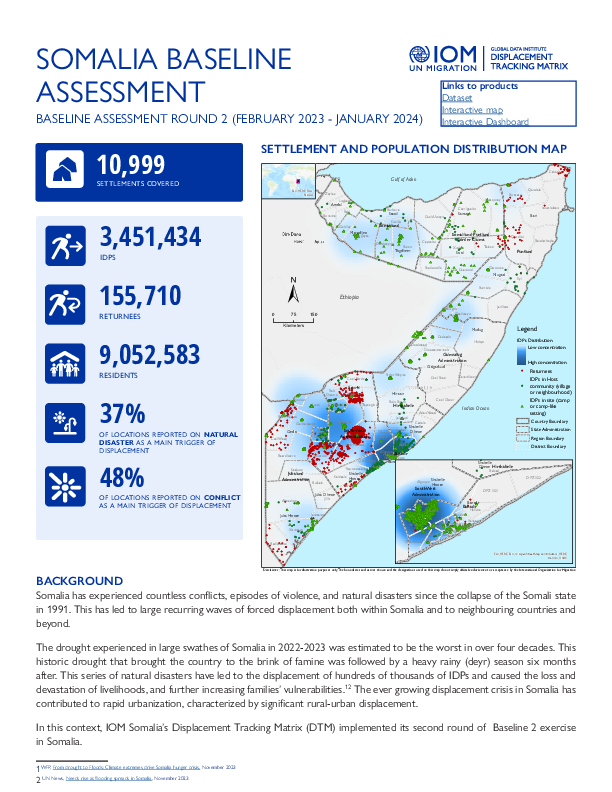
Contact
DTM Somalia, IOMSomaliaDTM@iom.int
Language
English
Location
Somalia
Period Covered
Feb 01 2023
Jan 31 2024
Activity
- Mobility Tracking
- Baseline Assessment
Baseline 2, an area-based assessment, is the second step of Mobility Tracking implemented at settlement level and aims to quantify presence of population categories.
As of January 2024, DTM Somalia has mapped around 3,451,434 IDPs, 155,710 returnees and 9,052,583 residents across 17 regions and 10,999 assessed locations. IDPs were present in 45 per cent of locations assessed (4,611 locations) and returnees were present in eleven per cent of assessed locations (1,204 locations)
The results include regions of origins, reasons for displacement and accessibility information, as well as the Operational Zones (OPZ) established by OCHA. These zones are designed to support sub-district response and reporting efforts.
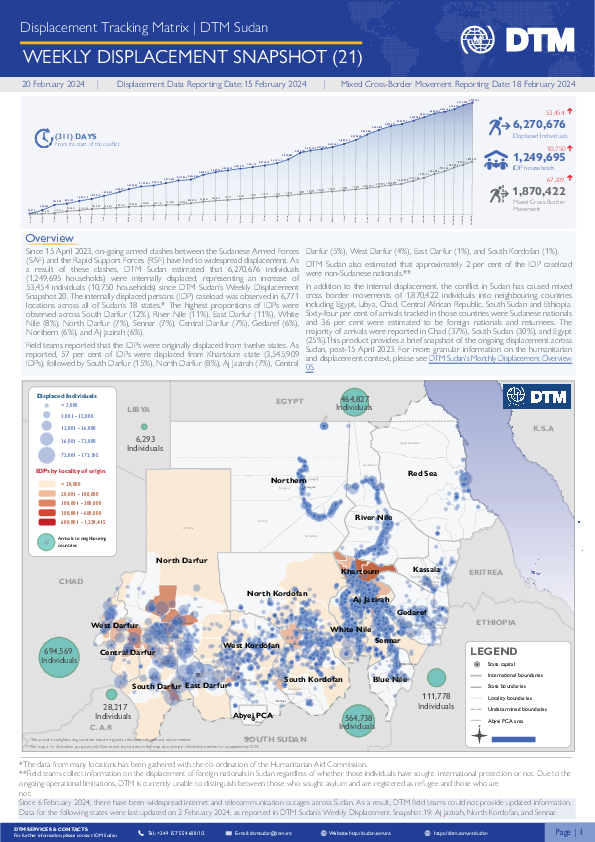
Contact
DTM Sudan; dtmsudan@iom.int
Language
English
Location
Sudan
Period Covered
Feb 08 2024
Feb 14 2024
Activity
- Mobility Tracking
- Baseline Assessment
Overview
From 15 April 2023, armed clashes erupted between the Sudanese Armed Forces (SAF) and the Rapid Support Forces (RSF) in multiple cities across Sudan. Clashes initially took place in cities across Northern and Khartoum states, later spreading across the Darfur and Kordofan regions.
Highlights
- DTM Sudan estimates that 6,270,676 Individuals (1,249,695 Households) were recently internally displaced.
- The IDP caseload was observed in 6,771 locations across all of Sudan’s 18 states.
- The highest proportions of IDPs were observed across South Darfur (12%), River Nile (11%), East Darfur (11%), White Nile (8%), North Darfur (7%), Sennar (7%), Central Darfur (7%), Gedaref (6%), Northern (6%), and Aj Jazirah (6%).
- Field teams reported that the IDPs were originally displaced from twelve states. As reported, 57% per cent of IDPs were displaced from Khartoum state (3,545,909 IDPs), followed by South Darfur (15%), North Darfur (8%), Aj Jazirah (7%), Central Darfur (5%), West Darfur (4%), East Darfur (1%), and South Kordofan (1%).
- IOM-DTM also reported that an estimated 1,870,422 mixed cross-border movements were made into neighbouring countries.
- This product provides brief insights into those displaced in Sudan post-15 April 2023. For more granular information on the IDP caseload and the displacement context, please see IOM-DTM's Monthly Displacement Overview (05).
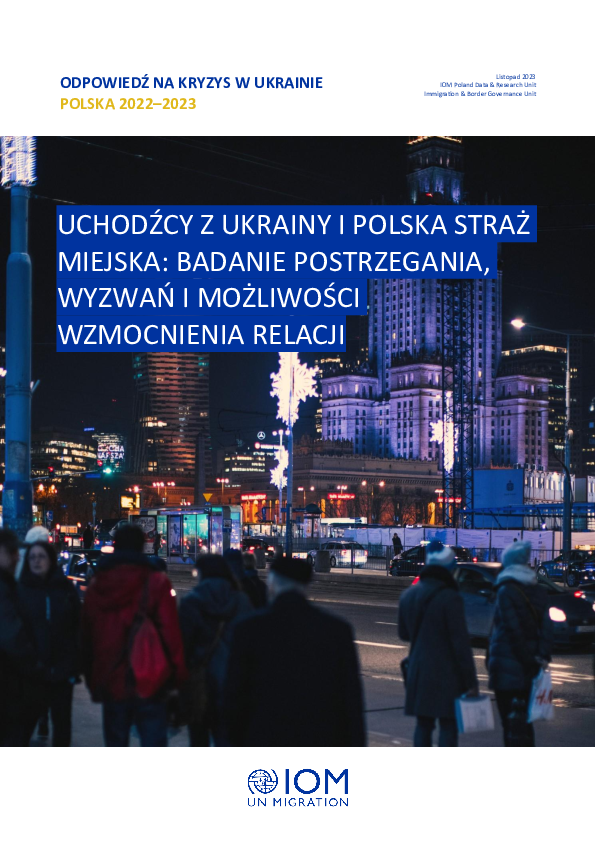
Contact
DTM Poland: IOMDTMPoland@iom.int
Language
Polish
Location
Poland
Period Covered
Oct 09 2023
Nov 10 2023
Activity
- Survey
- Community Perception
Według stanu na grudzień 2023 r. ponad 6 mln uchodźców z Ukrainy uciekło do innych krajów z powodu wojny, która rozpoczęła się w lutym 2022 r. Ponad 950 000 z tych uchodźców żyje w Polsce. W obliczu nagłego napływu uchodźców polskie społeczeństwo i instytucje szybko zareagowały, aby wesprzeć nowo przybyłych Ukraińców, wprowadzając programy ochrony socjalnej, zbiorowe budownictwo mieszkaniowe oraz udzielając natychmiastowej pomocy osobom przekraczającym granicę z Ukrainą. Polskie organy ścigania — w tym polska straż graniczna, Policja i Straż Miejska — odegrały kluczową rolę we wspieraniu ukraińskich uchodźców. Ponieważ konflikt trwa i wielu uchodźców mieszka w Polsce od ponad roku, istnieje potrzeba prowadzenia badań i programów w zakresie różnych aspektów umożliwiających trwałe rozwiązania — jednym z nich jest sposób, w jaki ukraińscy uchodźcy wchodzą w interakcje z polskim prawem i postrzegają polskie organy ścigania. Znaczna populacja Ukraińców żyła w Polsce jeszcze przed wybuchem wojny, co oznacza, że interakcje polskich funkcjonariuszy organów ścigania z Ukraińcami i ich spostrzeżenia mogą dotyczyć zarówno uchodźców, którzy przybyli po, jak i migrantów, którzy przybyli przed lutym 2022 r. Z punktu widzenia organów ścigania rozróżnienie, czy dana osoba jest uchodźcą, może być trudne, dlatego badamy również spostrzeżenia i doświadczenia ukraińskich migrantów, którzy mieszkali w Polsce przed wybuchem wojny (tj. tych, którzy żyli w Polsce przed lutym 2022 r.). Celem badania jest przedstawienie wglądu w interakcje, spostrzeżenia i potencjalne obszary wymagające poprawy w stosunkach pomiędzy Ukraińcami w Polsce (ze szczególnym uwzględnieniem populacji uchodźców) a polskimi organami ścigania (ze szczególnym uwzględnieniem polskiej Straży Miejskiej). W raporcie zawarto główne wnioski z badań IOM, a także zalecenia dotyczące zarówno współpracy polskich organów ścigania ze społecznościami ukraińskimi, jak i przyszłych programów pomocy humanitarnej.
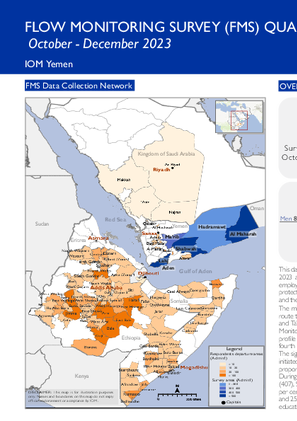
Contact
DTM Yemen, DTMYemen@iom.int
Language
English
Location
Yemen
Period Covered
Oct 01 2023
Dec 31 2023
Activity
- Survey
- Flow Monitoring Survey
- Flow Monitoring
This dashboard compiles flow monitoring survey (FMS) data collected in Yemen between October and December 2023 and provides an analysis of migrants’ demographic and socio-economic profiles, including education and employment backgrounds, reasons for leaving their country of origin or habitual residence, future travel intentions, protection and challenges faced during the journey. Also included are migrants’ highest level of education achieved and their labour status prior to moving.
The migration routes in the southern part of Yemen are categorized along two main routes: the south-eastern route towards Shabwah, Hadramawt, and Al Maharah governorates and the north-eastern route towards Lahj and Ta’iz governorates. Both routes are travelled by a large number of migrants each year. Through the Flow Monitoring Registry tool, which focuses on total numbers of migrants (as opposed to the more detailed migrant profile established through the FMS).
DTM recorded 4,853 migrants entered Yemen through the south in the fourth quarter of 2023. This figure represents a significant decrease (-68%) compared to the previous quarter. The significant and steady decrease observed since August is likely attributed to the ongoing joint military campaign initiated to combat smuggling and secure the coastline of Lahj, a well-known governorate for receiving the largest proportion of migrants. The campaign involved deploying troops, conducting raids, and establishing checkpoints.
During the fourth quarter of 2023, a total of 2,897 surveys were conducted. In Aden (435), Lahj (636), Ma’rib (407), Shabwah (609), Hadramawt (174) and Al Maharah (636). The overall number of surveys increased by seven per cent over the previous quarter. The majority of respondents were young male adults between the age of 17 and 25 (75%) searching for economic opportunities (97%), most of whom were single (94%), attained primary education or less (61%), were currently unemployed (95%) and departed from rural areas (67%).
Pagination
- Previous page
- Page 49
- Next page
